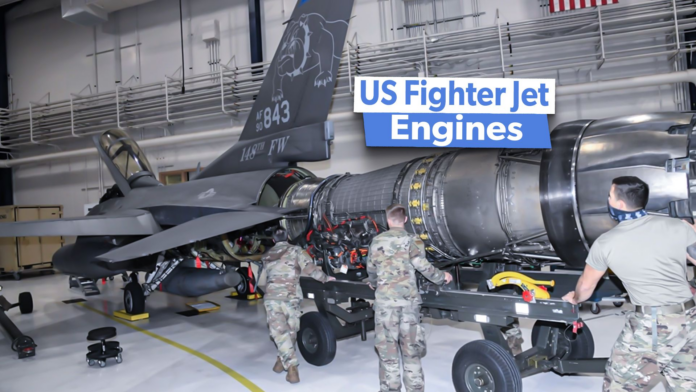Fighter jets are some of the most capable and robust aircraft in the skies. They are designed to be supermaneuverable while also flying at incredible speeds. As a result, fighter jets will need to be equipped with incredibly powerful engines, those capable of powering an aircraft to supersonic flight while also helping support the maneuverability required for fighter operations.
Get all the latest aviation news from Simple Flying!
The jet engines that power America’s fighter jets are typically built by legacy engine manufacturers, including Pratt & Whitney and General Electric, typically in collaboration with the primary contractor behind a given aircraft program. Unlike commercial jet engines, which may be used to power multiple different aircraft programs, military-grade jet engines are typically designed for a specific fighter jet and are not often applied to multiple programs (with some exceptions).
Photo: United States Air Force | DVIDS Hub
Without robust engines capable of supporting them, fighter jets would likely be in a far weaker position to perform their all-important missions, and an optimal engine is a key element of any fighter development program. Defense contractors are well aware of this, and this is why most have long-standing relationships with manufacturers. RTX, a company formerly known as Raytheon Technologies, even went so far as to acquire legacy engine manufacturer Pratt & Whitney.
Nonetheless, not all military engine programs are built the same, and some go on to be far more successful than others. Let’s take a deeper look at five of the most important engines that power US fighter jets today.
1 Pratt & Whitney F135
Primary application: Lockheed Martin F-35 Lightning II
Category: Pratt & Whitney F135 Specification: Dry weight: 6,422 pounds Bypass ratio: 0.57:1 Maximum thrust: 43,000 foot pounds
The Pratt & Whitney F135 is an afterburning turbofan engine designed exclusively for the F-35, America’s next-generation multirole strike fighter. The engine has two variants, one which is equipped for the Conventional Take-Off and Landing (CTOL) F-35A variants used by the United States Air Force (USAD) and Catapult Assisted Take-Off Barrier Arrested Recovery (CATOBAR) F-35C variants that land on the decks of the United States Navy’s aircraft carriers.
Photo: United States Air Force
A separate variant of the engine features a two-cycle configuration for the Short Take-Off Vertical Landing (STOVL) F-35B which is used by the United States Marines. This engine includes a forward lift fan, according to the manufacturer, and the first production variants were delivered to Lockheed Martin in 2009. The F135 beat out a competing engine, the F136, which was manufactured by both Rolls-Royce and General Electric, in a bid to power the next-generation fighter.
2 Pratt & Whitney F119
Primary application: Lockheed Martin F-22 Raptor
Category: Pratt & Whitney F119 Specification: Dry weight: 5,000 pounds Bypass ratio: 0.30:1 Maximum thrust: 35,000 foot pounds
The Pratt & Whitney F119 is an afterburning turbofan engine, two of which are used to power the Lockheed Martin F-22 Raptor, one of the most advanced and capable fighters ever built. The engine was designed to allow for supercruise, sustained supersonic flight without the use of afterburners.
Close
The engine’s nozzles incorporated thrust vectoring technology, allowing the engine’s thrust to be developed in a 20-degree spread relative to the pitch access, giving the aircraft exceptional maneuverability. The F-119 would be one of the key inspirations for the F-135, the engine that would incorporate many of its predecessor’s design elements to power the F-35 Lightning II.
3 General Electric F110
Primary applications: Grumman F-14 Tomcat, McDonnell Douglas F-15 Eagle, Boeing F-15EX Eagle II, General Dynamics F-16 Fighting Falcon
Category: General Electric F110 Specification: Dry weight: 3,830 pounds Bypass ratio: 0.87:1 Maximum thrust: 16,600 foot pounds
The General Electric 110, an afterburning turbofan built by American manufacturer GE Aerospace, is one of the most widely used engines by fighter jets in the United States Air Force today. The engine was derived from the earlier General Electric F101 as an alternative powerplant for the F-14 and F-16, competing with the rival Pratt & Whitney F100.
The aircraft would eventually be used to power newer variants of the F-15 Eagle and has been licensed for application to many foreign aircraft programs. The F118, a conventional non-afterburning variant of the engine, powers some variants of the Lockheed U-2 spy plane and also serves as the primary engine for the Northrop Grumman B-2 Spirit stealth bomber.
4 General Electric F404
Primary applications: McDonnell Douglas F/A-18 Hornet, Northrop F-20 Tigershark, Lockheed F-117 Nighthawk
Category: General Electric F404 Dry weight: 2,282 pounds Bypass ratio: 0.34:1 Maximum thrust: 17,700 foot pounds
Photo: BlueBarronPhoto l Shutterstock
The General Electric F404 is an afterburning turbofan engine that was designed by the American manufacturer for use on the General Dynamics F-16 Fighting Falcon, although the engine has been used on several other different aircraft. Several variants were built, including the F414, a larger engine that powered the F/A-18 Super Hornet, as well as the experimental GE36 propfan engine, according to the National Air and Space Museum.
5 Rolls-Royce F402 Pegasus
Primary application: McDonnell Douglas AV-8B Harrier II
Category: Rolls-Royce F402 Pegasus: Dry weight: 3,960 pounds Bypass ratio: 1.2:1 Maximum thrust: 23,800 foot pounds
Photo: BlueBarronPhoto l Shutterstock
Another engine capable of directing thrust downwards, the Rolls-Royce Pegasus is a British turbofan engine designed originally by manufacturer Bristol Siddeley and later by Rolls-Royce. The engine’s impressive capabilities have made it the key powerplant for the McDonnell Douglas AV-8B Harrier, a vertical takeoff jet used by the United States Marine Corps. According to Purdue University’s Department of Engineering, the engine has no computerized system for thrust vectoring, making it notoriously difficult to fly.



